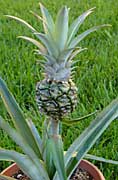


Home
Flowers &
Indoor Plants
Fruits & Nuts
Ornamentals
Vegetables
Special Topics
Resources
Glossary

|
Pineapple Ananas comosus (ah-nah-nas com-oh-sus) 
Click on thumbnails for larger image. |
 |
What about it? Yet again we have another crop that cannot be grown in the Northeast! The pineapple is grown everywhere in the tropics and in some favored parts of the subtropics. The fast European to enjoy pineapple was Columbus, the pineapple began to spread throughout the world shortly thereafter. This was not difficult, since the crown (and other plant parts) can withstand drying up very well. In fact, you can propagate a pineapple plant at home by removing the crown from the fruit and placing it in vemuculite or other potting media. What is it used for? Pineapple is mostly eaten in processed form: slices, juice, chunks and diced pineapple are familiar items. Fresh pineapple is available in most supermarkets, and has an intensity of flavor that makes buying this fruit worth the expense! Where does it grow? How do we grow it? Pineapples are commercially grown in the tropics. Most growers stagger the rows; two rows make a "bed," and between the beds is space to walk. Some growers "interplant" pineapple with other crops. This means that instead of having a single planting of pineapple, there are crops grown in between the rows of pineapple. What are its primary problems? Mealy bug wilt a wilt caused by the toxic effect of mealybug feeding, is the most widely distributed pineapple problem and probably also one of the most damaging. Yellow spot, transmitted by thrips, and nematodes are also common in pineapple plantations. Other pineapple pests are scales, mites, and fruit flies. How do we harvest and store it? Home gardeners in the tropics harvest their pineapples by hand, but the work is mechanized on large pineapple plantations. The fruit is picked ripe, unless is is harvested for export. The change in color helps growers decide if the fruit is ripe, as well as the sound made while tapping the friut (much in the same way northern gardeners test their melons for ripeness). Fresh pineapple that has been purchased ripe should be eaten right away.
© Copyright, Department of Horticulture, Cornell University. |